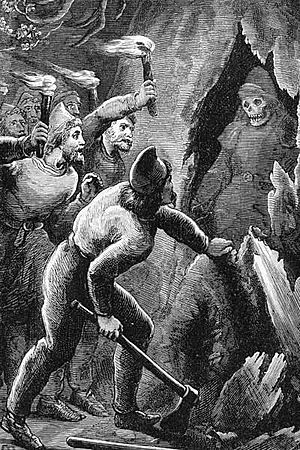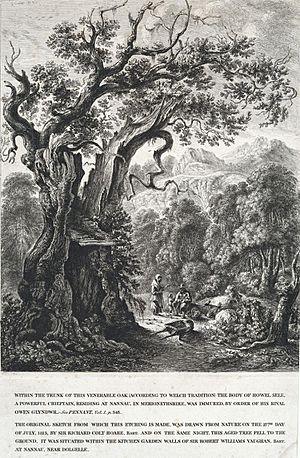Hywel Sele facts for kids
Quick facts for kids
Hywel Sele
|
|
|---|---|

The discovery of the body of Hywel Sele in the Nannau Oak
|
|
| Died | 1402 Nannau Estate, Wales |
Hywel Sele (who died around 1402) was a Welsh nobleman. He was a distant cousin of Owain Glyndŵr, who was a very important Welsh leader and the last native Prince of Wales. Hywel Sele was also a friend of the English King Henry IV. Because of this, he did not support his cousin Owain Glyndŵr's rebellion, known as the Glyndŵr Rising, which lasted from 1400 to 1415.
Hywel Sele was captured by Glyndŵr. However, he was later invited to go hunting with his cousin on the Nannau Estate. During this hunt, Hywel Sele tried to kill Glyndŵr, but he failed. Instead, Hywel Sele was killed, and his body was hidden inside a hollow oak tree. This oak tree later became famous and was said to be haunted. It was called Derwen Ceubren yr Ellyl, which means "The Hollow Oak of the Devils," or Ceubren yr Ellyll, meaning "The Hollow Tree of the Ghost."
The Story of Hywel Sele
There are a few different versions of Hywel Sele's life story.
Hywel Sele was a distant cousin of Owain Glyndŵr. Glyndŵr was a powerful Welsh leader who fought against English rule. Hywel Sele was friends with the English King Henry IV. Because of this friendship, Hywel Sele was against Glyndŵr's rebellion, called the Glyndŵr Rising.
According to one story, Hywel Sele fought against Glyndŵr and was captured. An attempt to free him failed in a battle. Later, a religious leader from Cymer Abbey helped the two cousins make peace. After this, they went hunting together on the Nannau Estate.
During the hunt, it is said that Hywel Sele aimed his bow to shoot Glyndŵr. But Glyndŵr was quick and struck Sele with his sword before the arrow could be fired. Glyndŵr was worried about what the abbot would say. So, he hid Hywel Sele's body inside a hollow part of a very old oak tree. This tree later became known as Derwen Ceubren yr Ellyl, or "The Hollow Oak of the Devils."
After this, Glyndŵr burned down Hywel Sele's home. Sele's two-year-old son was then raised by an uncle. A cousin of Sele, Gruffydd ap Gwyn, heard about the burning of the estate. He gathered 200 men to rescue Hywel Sele. But Glyndŵr ambushed Gruffydd's group at Llanelltyd Bridge. Glyndŵr killed sixty of Gruffydd's men and then burned down Gruffydd's own lands.
The Mysterious Nannau Oak
The tree where Hywel Sele's body was supposedly hidden became known as the Nannau Oak. A writer named Thomas Pennant saw the oak tree in 1778. He noted that it was very large, about 27 feet (8.4 meters) around. However, it was already very old and decaying. People said the tree looked like a gothic arch.
The Nannau Oak finally fell down on July 13, 1813. It is said that when it fell, Hywel Sele's body was found inside. His remains were then supposedly buried at Cymer Abbey. Sir Richard Colt Hoare, an artist, was there when the tree fell. He had even drawn a picture of the tree that very morning. His drawing shows the tree looking old and damaged, possibly by lightning.
Just like the story of Hywel Sele, there are different ideas about the tree. Some accounts say Sele's body was only in the tree for about forty years. The oak was also known as Ceubren yr Ellyll, "The Hollow Tree of the Ghost." Many people believed it was haunted and were afraid to go near it at night.
The spot where the tree stood was marked with a sundial and a brass plate. This plate had a drawing of the tree on it. The landowner had the wood from the fallen tree made into various useful items. It is also said that many homes in Dolgellau had a picture of the tree in a frame made from its wood. The famous writer Walter Scott even wrote about the tree in his 1808 poem Marmion, calling it "the spirit's Blasted Tree."


